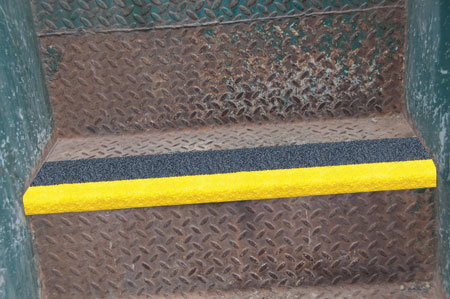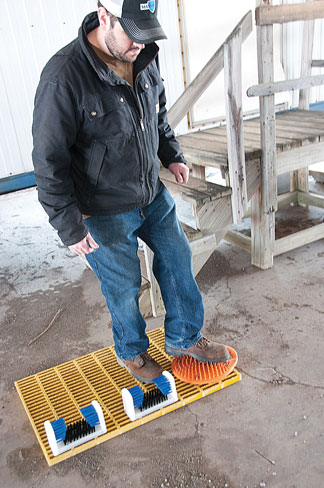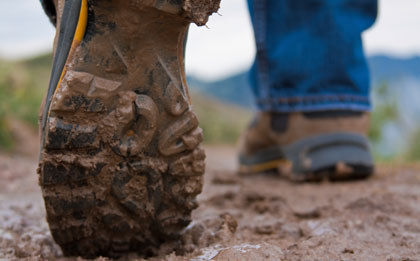Tips for keeping your work crews sure-footed
Slips happen. A simple misstep on a wet walkway or gunky ladder rung can send you reeling. When slips—and the trips and falls that often follow—occur on the jobsite, a lot comes crashing down as a result, including staggering loss of productivity and business for the employer, and lost wages and reduced quality of life for the worker.

Yes, little slips add up to big numbers. The Industrial Safety and Occupational Health Markets (5th edition) reports that 85 percent of workers’ compensation claims are attributed to employees slipping on slick surfaces. A whopping $70 billion is paid out annually for compensation and medical costs associated with employee slip/fall accidents, per the National Safety Council. When workers go down, other things skyrocket: industrial insurance premiums and costs associated with training replacement workers, not to mention a person’s pain, temporary or permanent loss of mobility, and risk for depression due to a compromised lifestyle.
THE CAUSE OF SLIPS
The good news is that most slips and related trips and falls can be prevented. Technically, a slip constitutes too little friction or traction between one’s foot or work boot and the walking or working surface. Something makes the surface of the walking or climbing area … well, slippery: dampness, oil, water, mud, slush, or gunk. The result is loss of balance.
Less obvious is when you’re the carrier of the slipping material, like muck on shoes. Migrating contaminants are a leading cause of slippery floors, so it becomes crucial to get that dealt with before it leads to someone climbing a ladder with slippery shoes. In fact, slipping is mostly the result of slop being carried from point A to point B.
Slips and falls on walking and climbing surfaces in the mobile workplace can be caused by several conditions.

- Wet weather. Rain is one of the most common culprits. Frost, snow, sleet, and ice can be a factor, as can fog or mist (especially in the early morning hours).
Lack of lighting. Slipping hazards are harder to see in poorly lit work areas. - Dirty footgear. Such as wet, greasy, mucky, and muddy work boots.
- Tracked-in residue. Outdoor workers can bring mud, muck, and wetness onto climbing and walking surfaces, such as ladders, scaffolding, truck running boards and beds, equipment platforms, jobsite trailers, shops, and lunchrooms.
- Haste makes waste, too. Hurry, scurry, and rushing are major contributors, especially when workers are coming and going on work breaks or dashing to punch the clock at the end of a shift.
ANTI-SLIP TIPS
So how can companies and their workers best lessen slips?
Maintain good housekeeping. Make sure that all areas are clean and in a sanitary condition. Keep floors clean and dry. It is of utmost importance to ensure that the bulk of mud, muck, and slush are removed before climbing on ladders, scaffolding, and other equipment, and even before walking into transition areas in buildings or vehicles. Get rid of contaminants.
Create an entrance cleaning system. This can be in the form of scrubbers, scrapers, and soppers—anything that effectively deals with “field service conditions.”
Install anti-skid walking surface materials in critical areas. These areas include steps, platforms, and ladder rungs.
Develop proper cleaning protocols. Design workplace processes that help to prevent potential exposures to slips, strains, and falls.
Train, train, train. Make sure that safety, risk management, operations managers, and executives have this as part of their training programs. Train employees to “see” trouble spots before an accident happens, as well as how to “fall properly.” Instruct workers to wear proper footwear with good traction. While some training may need to take place in a classroom setting, the most effective sessions will revolve around hands-on training that is site-specific to actual workplace and seasonal conditions.
Keep safety at the forefront of workers’ minds. Weekly “traction tips” presented by frontline workers and supervisors to the entire team can be extremely effective.
Utilize proper warning signs for wet floor areas. Ensure signage is erected promptly when wet floor areas surface.
Slips and falls in the mobile workplace continue to happen. Understanding their root causes, developing effective control methods, and training consistently are critical to reducing them. Finally, in order to succeed, a company’s slip-and-fall program must have unfailing management support and complete employee commitment.
The average person takes 8,000 steps a day, according to NFSI, but it only takes one step to destroy a life. Be aware that slips can happen, and be safe out there, folks.
■ ■ ■
[divider]
For More Information Donny Beaver is CEO and co-founder of HalenHardy, LLC, a company that develops tools to tackle crappy and dangerous jobs for the mobile workforce. Its innovative line of MudKill boot cleaning and GritGrab traction products can substantially reduce slips and falls. HalenHardy is a corporate sponsor of the National Flooring Safety Institute. To learn more, visit www.HalenHardy.com, or email dbeaver@halenhardy.com.
Modern Contractor Solutions, June 2014
Did you enjoy this article?
Subscribe to the FREE Digital Edition of Modern Contractor Solutions Magazine!


